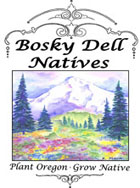
West Linn, Oregon
PHONE 503-638-5945
FAX 503-638-8047
9am to 5pm 7 Days a Week
(Closed Sundays in November, December, January, February)
Gardens
for Birds
 |
|
23321 SW Bosky Dell Ln. West Linn, Oregon PHONE 503-638-5945 FAX 503-638-8047 9am to 5pm 7 Days a Week (Closed Sundays in November, December, January, February) |
| Home |
| Greeting Cards |
| About Us |
| Plant Lists |
|
Hummingbird Gardens |
|
Gardening for Birds |
| Butterfly Gardens |
| Erosion Control |
| Lewis and Clark |
| Plant Sales |
| handouts |
| Websites |
| Native Plant Recipes |
| Judy Bluehorse |
| Guestbook |
| Mailing List |
| Employment Opportunities |
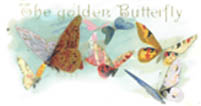
|
| Butterfly Gardening |

|
While many flowers provide nectar for a wide variety of butterflies, some species require specific native plants to feed their caterpillars. Endangered Oregon Silverspot Butterflies lay their eggs only on Viola adunca (below, right), because their caterpillars must eat it's leaves to survive.
The Monarch caterpillar eats the leaves of milkweed species (above left), whose poison doesn't kill the larvae, but makes the adult toxic to predators! Many flowers bred for their showy blooms do so at the expense of nectar production, while native flowers provide for the butterflies with greater sources of nectar. When these plants disappear, so do our butterflies.At Bosky Dell Natives, you will find many native plants crucial to the survival of local butterflies. Review this news feature for information on what you can do to help these beautiful winged creatures, and use the following table to determine what you might add to your garden.
 |
 |
 |
 |
 |
| Host Plants · Butterfly | Nectar Sources |
Trees
Shrubs
Grasses and Forbs
|
Trees
Shrubs
Grasses and Forbs
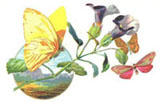
Note: Butterflies select nectar plants based on the physical structure of the flower and the amount of nectar it produces. They like tubular flowers, such as Penstemons, and favorites usually have many flower heads and numerous small florets, such as Yarrow. Remember to choose plants with long blooming periods, such as asters, and species with different bloom seasons. Adult butterflies also feed on sugars in the sap of wounded trees, and rotting fruit. |
Featured Guest Writer - Rachel Davies - Age 14
I volunteer at the Oregon Zoo as a zooteen, where this summer they installed a new temporary exhibit by the name of Winged Wonders. For the extra fare of two dollars a piece, visitors can enter a white mesh domed tent about 100 ft. by 20 ft., where approximately 700 butterflies fly freely and live out their short life spans. Winged Wonders is, essentially, an
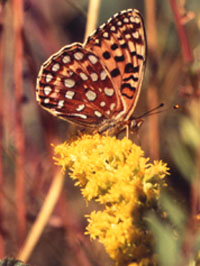
By progagating Viola adunca, Bosky Dell Natives is helping to save the threatened Oregon silverspot butterfly (Speyeria zerene hippolyta, nectaring on godenrod, above). Once a regular inhabitant of the Oregon coast, silverspot populations have plummeted in recent years. The caterpillar eats only the leaves of Viola adunca, and this native violet is now harder to come by. As a result of habitat destruction and fire suppression, the Viola's meadow habitat has been replaced in many areas by grasses, shrubs and trees. A cooperative effort, funded by the U.S. Department of Fish and Wildlife, is aiming to supplement existing populations and restore the butterfly's habitat. The Oregon Zoo is helping to ensure the surival of viable populations while the butterfly's habitat is restored. The Zoo rears caterpillars in its lab, feeds the larvae adunca leaves, and returns the chrysalis' to Cascade Head, a Nature Conservancy site in southern Tillamook County. We are one of the Zoo's sources of Viola adunca, and limited quantities are available for retail sales (call ahead for availability). To read more about the project, visit the Zoo's website at www.oregonzoo.org, the Fish and Wildlife website, or UCBerkely at Shanana.berkely.edu
To begin with, there are two categories of plants you will need in your garden if you wish butterflies to remain there throughout the extent of the summer. There are nectar plants, which the adult butterflies get their nourishment from, and host plants for larvae, which butterflies will lay their eggs on. Nectar plants are easy to explain; they are simply flowers containing nectar, which adult butterflies will stick their long straw-like-tongue down into to collect their food. Host plants, on the other hand, provide food for larvae after they hatch out of their eggs. For this reason, butterflies will lay their eggs only on host plants, and will eat only out of nectar plants.
If you want to create a haven for butterflies, you will have to eliminate the use of pesticides. Most pesticides will kill caterpillars and butterflies, as well as beneficial insects. Use nontoxic alternatives, and allow your leaves to be chewed. The trade off is more than worth it, when you see the gorgeous reds, coppers, oranges, blacks and blues flitting about your garden.
Butterflies also need shelter, sun, and water. Remember - they can't fly without the sun's help to raise their body temperature and metabolism, so planting in a sunny spot will bring the butterflies out on sunny days. Provide basking sites, like light rocks or boulders, for them to warm up on, and shelter from the wind. Butterflies also like to drink from muddy spots with very shallow water, where they "puddle" and benefit from the water and the dissolved minerals. It is easy to create a shallow dish of mud or gravel, or to add a stone to the center of a bird-bath sized water source. Then sit back, relax, and enjoy the view on one of our beautiful warm summer days!
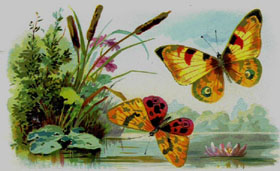
In memory of Larry Everson, a wonderful gentleman in Milwaukie who shared much time and information with me, not to mention his gorgeous photographs, many included on these pages. Larry's expertise and craft were shared with many who chose to purchase his photos or take his butterfly gardening classes.
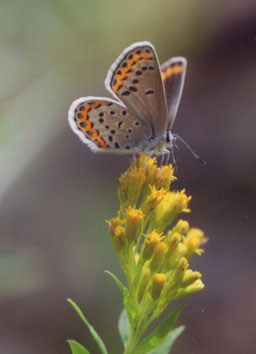
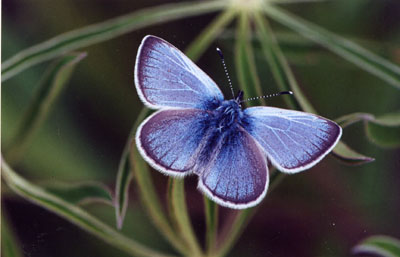
Thanks also to Bruce Newhouse, for the up-to-date tables recording local butterflies and their host plants and nectar sources. See our link to the North American Butterfly Association.